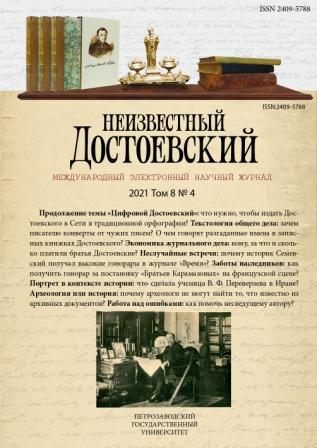Из редакционного архива братьев Ф. М. и М. М. Достоевских (журналы «Время» и «Эпоха»)
From the Editorial Archive of the Journals “Vremya” and “Epokha” Published by the Dostoevsky Brothers
Author(s): Lyubov V. AlekseevaSubject(s): Media studies, Archiving, Russian Literature, 19th Century, Philology
Published by: Петрозаводский государственный университет
Keywords: editorial archive; “Vremya”; “Time”; “Epokha”; “Epoch”; Fyodor Dostoevsky; Mikhail Dostoevsky; pochvennichestvo; native soil; attribution; credit and debit notebook; payroll record; journalism;
Summary/Abstract: The journals “Vremya” and “Epokha” attracted the attention of researchers primarily in connection with the personality and work of the writer Fyodor Dostoevsky. This fact determined the nature of the study of these journals: they are least researched as independent periodicals in the 1860s, with most of the works being devoted to specific aspects. Despite the increased attention of researchers to “Vremya” and “Epokha in recent decades, many questions remain unresolved: the editorial and royalty policy of journal”s and the financial side of the publication have not been sufficiently studied, the key problem of attribution of anonymous and pseudonymous journal articles has not been fully resolved, i.e., in regard to the co-authorship and editorial work of F. M. Dostoevsky, and the determination of the degree of the writer’s contribution to the articles by other authors. The article not only enumerates the problems of studying “Vremya” and “Epokha” and the role of Dostoevsky in these journals; it also presents an analysis of certain materials from the editorial archive. The entries of a credit and debit notebook offer insight into the financial side of the publication (costs and income of the editorial office), the conduct of editorial and publishing affairs by the Dostoevsky brothers, and allow to judge the success of their enterprise. A payroll record includes receipts from employees for the honoraria received for their work and publications. The editing fee system is determined by the ratio of the costs of fees to the amounts received by the journal staff on the payroll record. The materials from the editorial archives of “Vremya” and “Epokha” analyzed in this article contain valuable information for attribution of anonymous and pseudonymous journal texts. The analysis of editorial records, correspondence of journal employees, memoirs and other documentary sources allow to confirm existing attributions or find contradictions in them and highlight the most reliable ones. The analysis of the materials from the editorial archives of “Vremya” and “Epokha” significantly expand the understanding of these two periodicals of the 2nd half of the 1860s and the writer’s related activities as part of his creative work. These documents open up broad prospects for further study and search for answers to questions.
Journal: Неизвестный Достоевский
- Issue Year: 8/2021
- Issue No: 4
- Page Range: 52-90
- Page Count: 39
- Language: Russian

